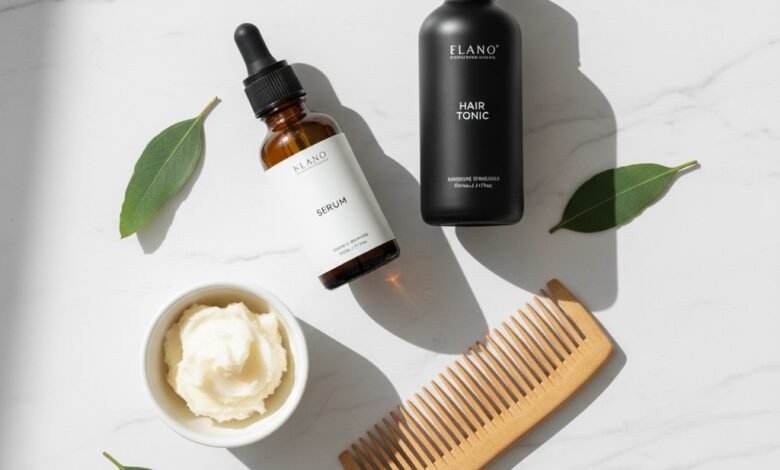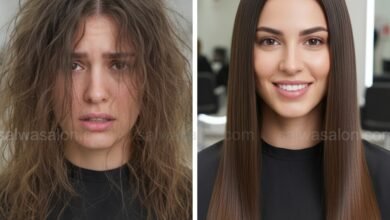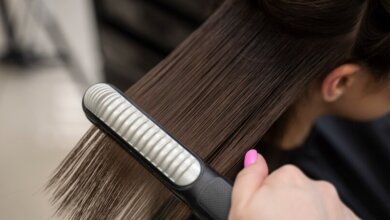The Complete Guide to Overcoming Hair Loss & Dryness: Scientific Analysis and Solutions

Finding strands of hair left on your comb or floor often triggers concern. Coupled with hair shafts that feel rough, dull, and unmanageable, the dual problems of hair loss and dryness become a complex issue. This isn’t merely an aesthetic concern; it’s often a signal of your overall hair and scalp health. As experts at Salwa Salon, we understand that effective solutions don’t come from trial and error, but from a deep understanding of the root causes.
This article is not just a list of ordinary tips. We will take you on a journey to delve into the ‘why’ and ‘how’ behind hair loss and dryness. Let’s dissect it together, from the cellular level to daily routines, to build a foundation for strong, healthy, and sustainably shiny hair.
Understanding the Root Causes: Why Does Hair Become Dry and Fall Out?
Before moving on to solutions, it’s crucial to differentiate between two conditions often considered the same: hair falling from the root (hair fall) and hair breaking (breakage) due to dryness. Both result in hair loss, but their causes and solutions are very different.
Fundamental Differences: Root Hair Fall vs. Hair Shaft Breakage
Hair Fall: This occurs when hair detaches entirely from the follicle (root sac) in the scalp. You will see a small white bulb at the end of the fallen hair—that’s the root. Hair fall is closely related to the hair growth cycle and internal body conditions, such as nutrition, hormones, and stress. This is a problem centered on scalp and follicle health.
Breakage: This occurs when the hair shaft breaks in the middle or at the ends. There is no visible root. The main cause is structural damage to the hair shaft, often triggered by extreme dryness, chemical processes (coloring, straightening), or excessive heat styling. Dry hair has an open and fragile cuticle (outer protective layer), making it highly prone to breakage.
Often, severe dry hair will lead to breakage, which is then perceived as hair fall. Therefore, addressing dryness in the hair shaft is a crucial preventive step to reduce breakage-related hair loss.
Key Triggering Factors: Internal and External Analysis
Hair problems are rarely caused by a single factor. Usually, it’s a combination of various triggers, both internal and external.
- Internal Factors: Include nutritional deficiencies (iron, zinc, biotin, protein), hormonal imbalances (postpartum, thyroid, chronic stress elevating cortisol levels), genetic factors, and certain medical conditions.
- External Factors: Include excessive heat exposure from styling tools, damage from harsh chemicals (sulfates in shampoo, bleaching processes), overly tight hairstyles (tying hair), and environmental aggressors like UV rays and pollution.
Holistic Strategy to Address Hair Fall from the Root
The focus of treating hair fall is on strengthening follicles and optimizing scalp condition. This is an ‘inside-out’ approach.
- Essential Nutrients for a Strong Follicle FoundationHair follicles are ‘factories’ that require quality fuel. Without proper nutrition, their production will slow down or stop. You need to ensure adequate intake of:
- Protein (Keratin): Hair is mostly made of keratin protein. Ensure sufficient protein intake from eggs, fish, lean meat, or legumes.
- Iron: This mineral is crucial for hemoglobin production in red blood cells, which carry oxygen to all body cells, including hair follicles. Iron deficiency (anemia) is one of the leading causes of hair loss.
- Biotin (Vitamin B7): Plays an important role in keratin production. Although biotin deficiency is rare, ensuring its intake from foods like egg yolks and avocados is very helpful.
- Zinc: Zinc is involved in hair tissue growth and repair. This mineral also helps maintain the proper function of oil glands around the follicles.
- Stress Management: Breaking the Cortisol and Hair Loss CycleChronic stress triggers the body to release high levels of the hormone cortisol. Cortisol can push a large number of hair follicles into a premature resting phase (telogen), known as telogen effluvium. Three months after a period of high stress, you may experience massive hair loss. Managing stress through meditation, exercise, or yoga is not just cliché advice, but a biological intervention to normalize your hair cycle.
- Targeted Scalp CareA healthy scalp is fertile ground for hair. Your care routine should focus on scalp health:
- Gentle Cleansing: Use sulfate-free shampoos (SLS/SLES) that cleanse without stripping the scalp’s natural protective oils. Harsh sulfates can cause irritation and inflammation in the follicles.
- Scalp Massage: Gently massaging with fingertips for 3-5 minutes during shampooing can increase blood circulation to the follicles, bringing more oxygen and nutrients.
Revitalizing Dry Hair: Restoring Moisture and Hair Shaft Integrity
To address dry hair, our focus shifts to the hair shaft itself. The goal is to hydrate, lock in moisture, and smooth the cuticle.
- Understanding Hair Care Ingredient CompositionNot all products are created equal. You need to be a smart consumer by understanding the three main categories of moisturizing ingredients:
- Humectants: These ingredients act like magnets, attracting water from the environment into the hair shaft. Examples: Glycerin, Hyaluronic Acid, Honey, Panthenol. Suitable for all types of dry hair.
- Emollients: These ingredients fill gaps in damaged hair cuticles, making the hair surface feel smoother and softer. Examples: Shea Butter, Cocoa Butter, Fatty Alcohols (like Cetyl or Stearyl Alcohol—these are ‘good’ alcohols that moisturize, not dry out).
- Occlusives: These ingredients form a protective layer over the hair shaft to lock in existing moisture and prevent it from evaporating. Examples: Dimethicone (silicone), Mineral Oil, Lanolin, Avocado Oil. Very effective for very dry and porous hair.
Good products usually contain a combination of these three types of ingredients to provide maximum hydration and protection.
- Protective, Not Damaging, Care TechniquesHow you treat your hair is as important as the products you use.
- Reduce Shampooing Frequency: Daily shampooing can strip natural hair oils. Adjust the frequency to every 2-3 days, depending on your scalp type.
- Use Room Temperature Water: Hot water can excessively open the hair cuticle and remove moisture. A final rinse with cool water can help seal the cuticle and add shine.
- Avoid Excessive Friction: After shampooing, do not rub your hair with a rough towel. Instead, gently pat it dry with a microfiber towel or an old cotton t-shirt to absorb excess water.
- Use a Weekly Hair Mask: Dedicate time once a week for an intensive treatment using a hair mask rich in emollients and occlusives. Leave it on for 20-30 minutes for maximum penetration.
- When to Seek Professional HelpWhile home routines are crucial, there are times when you need expert intervention. If your hair loss is severe and doesn’t improve after 3 months of self-care, consult a doctor or dermatologist to rule out potential medical conditions. For extreme dryness and damage, salon treatments like deep conditioning or keratin smoothing treatments can provide instant improvement to hair structure, making it stronger and more manageable while you continue home care.
Conclusion: Building a Long-Term Healthy Hair Routine
Addressing hair loss and dryness is not an instant fix, but a commitment to understanding and meeting your hair’s unique needs. By differentiating between hair fall and breakage, nourishing your body from within, and applying the right care techniques with suitable products, you are building a solid foundation for long-term hair health.
Remember that consistency is key. Give your body and hair time to respond to the positive changes you are making. Healthy and beautiful hair is a reflection of careful and understanding care.






